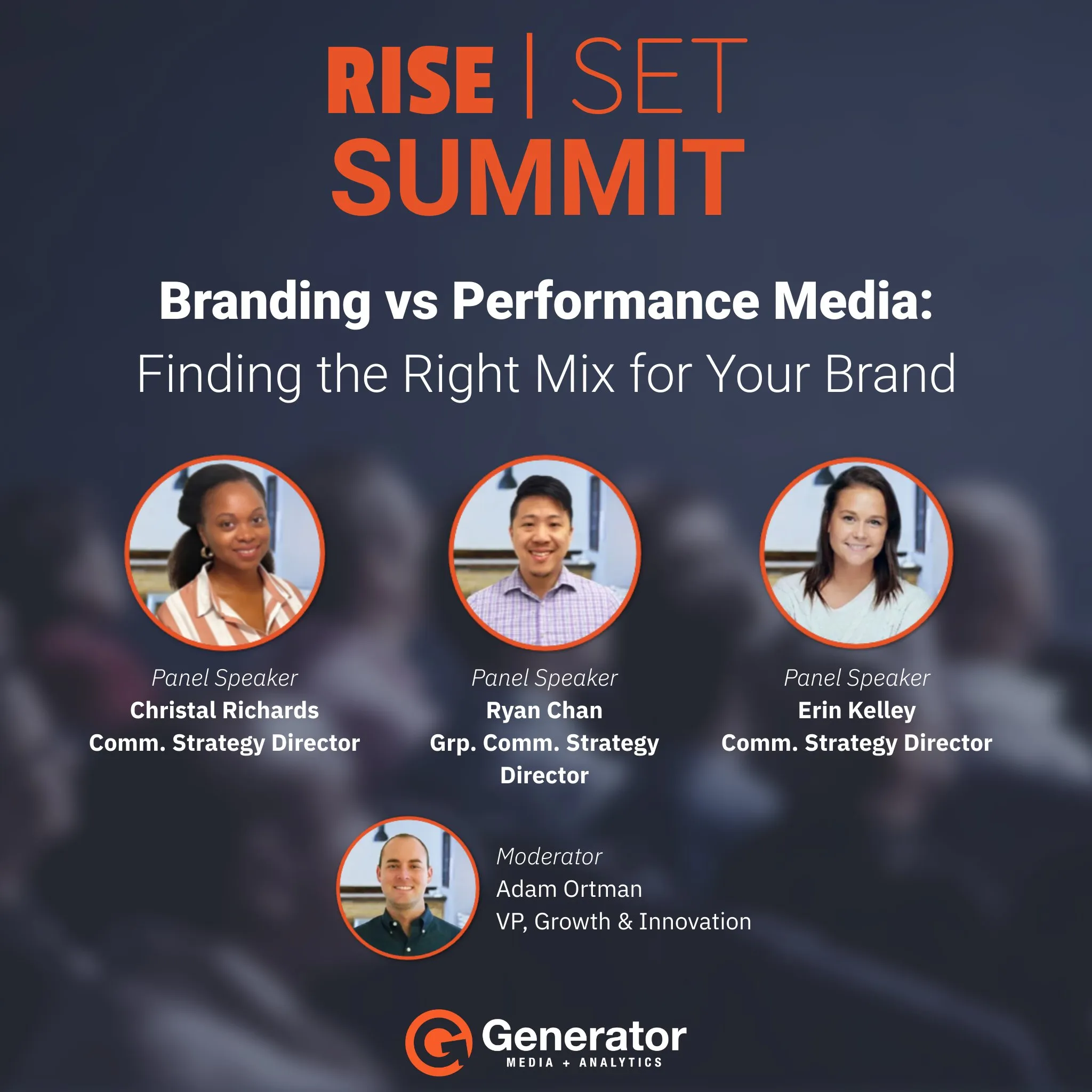Our panel of experts discuss an age-old question: What is the correct mix of branding (awareness) and performance (conversion) media for my brand? We discuss how the customer journey, a brand’s maturity and life stage, a test and learn mentality, and a robust measurement plan are all critical to a brand finding this perfect media mix.
An Introduction to the Generator Media + Analytics Panel:
Christal Richards – Communications Strategy Director: I joined Generator back in April with about 10 years of experience in media, particularly in the consumer-packaged goods world with a little sprinkle of pharmaceuticals, government, and retail. Throughout my time within the CPG world, I focused a lot on a full funnel marketing approach in terms of driving a brand forward. This is a topic that I’m very passionate about.
Erin Kelley – Communications Strategy Director: I have about eight years of experience in the media industry. Really my sweet spot has been in CPG, particularly for portfolio brands. I also went to the client side in pharmaceuticals before coming over to generator. I currently work on multiple different verticals including education, gaming, and CPG. I am really excited to be here today to discuss this topic with you all.
Ryan Chan – Vice President, Communication Strategy: I’ve been at Generator Media for a little over three years. In my past, I’ve really focused on several different overarching verticals. Whether it be travel, gaming, consumer technology, I’ve touched a little bit of everything.
Question: Why is this topic specifically important to you and why should we be discussing it today?
Christal:
I think there’s definitely been a shift in the industry and, more recently, even in the customer. I had taken a year off to travel and prior to doing that I was working on brands that were really heavily focused on building brand equity. I came back, meeting with different teams, and everyone was discussing performance media. I said to myself, “Okay, this is great, but if this is all everyone is talking about now, what happened to the need to form connections and build brand love?” There is great evidence out there from a performance media standpoint to drive sales, but how do we also broaden that up so that we can help to start to future-proof our businesses by bringing awareness and consideration tactics into the fold? Coming back into the industry from my time away, I can now really understand how these consideration and awareness tactics really help to form these strong connections with consumers and the importance there.
Erin:
I think a lot of brands struggle with this topic. Marketing teams get a lot of pressure from leadership to play the balance of immediate sales growth versus the longevity and growth of a brand. I’m often seeing clients being tasked to do both without infinite budgets. So, we get the questions: “How do I prioritize?” or “How do I advocate?” I do think that there are some frameworks here that can be applied, but it really is not ‘one size fits all’. It really is dependent on individual brands, a lot of different factors like how mature the brand is, the purchase cycle, pricing, competition, creative usage. These items, coupled with the fact that there’s new media touchpoints and tech coming out (it seems like every minute), it’s going to be just an ever-present topic. It’s our job as media partners to help our clients evaluate those individual circumstances for your brands and provide a recommendation for what we think will best perform. Long story short, I think there’s so many changing factors, it’s always going to be a consistent question that we get and it’s great that we’re discussing this today.
Ryan:
I think both Christal and Erin brought up excellent points in general. I think when there’s a disproportionate focus on conversions, there is a tendency to think that the consumer path to purchase is point A to point B. However, in reality, it starts ending up becoming closer to a complex spiderweb where there are a number of brands and touchpoints that take place even before a consumer is even starting to research his or her overall purchase. So, while conversion strategies do play an important role to solicit action and yield results, awareness and consideration allow brands to really scale on tactics that drive high conversion. Being able to actually lead to brand growth, which is just as important as direct sales, regardless of the category.
Question: How do different customer journeys result in different forms of branding and performance investment mixes?
Erin:
I can give a few examples here based off my past life. I was working on consumer packaged goods and portfolio brands back in the day and it was right when programmatic media first came out. We saw this really big shift with their competitive set and with our brands, pulling dollars out of TV and shifting it all into programmatic media because it was this shiny, new, really hyper-targeted tactic, which sounded really great. Eventually we started to see our sales decline, not only for our brands, but also for our competitive brands too. What we really saw was the degradation of this top-of-mind awareness purchase behavior. For example, products like popcorn aren’t really highly researched, products like these were highly impacted. So, what we really needed was more of this appropriate mix of brand building to set ourselves apart from the two to three competitors in the space with the appropriate amount of performance to capture demand. I like to use this analogy that compares branding to planting seeds and performance to harvesting. You must plant the seeds if you want to continue to harvest. If you want to fill the funnel so that you can convert, you have to build this brand awareness first.
Ryan:
I just love analogies in general, I love the harvesting one in particular. I think the only thing that I really would add is that any marketer understands the concept of the purchase funnel: awareness, consideration, and conversion. But ultimately, I think another way to really think about this is if you flip that funnel over and you have a triangle, with media awareness as the foundation (at the bottom). The way that I feel marketers and agencies should really understand awareness, consideration, and conversion is that once you start chipping away at that foundation, it becomes so much more difficult to really get to the top of that pyramid and start converting those as prospects. The more you take away from awareness, the less that can be pushed upward to conversion.
Christal:
Piggybacking off Ryan’s point with the pyramid, I think sometimes brands are too laser focused on that conversion portion. You miss out on so many other great opportunities to build relationships with consumers. Additionally, brands should ask themselves, “where is my brand within the marketplace?” If you’re solely focused on conversion tactics and your competitor is out-shouting you 10 to 1 with awareness, I’d say a consumer has already been messaged to 10 times by your competitors before they’ve even considered your brand. I think the point is to not be so laser focused on conversion but step back and look at your brand’s full journey from a consumer’s perspective. You want to reach your consumers before your competition does throughout that purchase journey.
Question: How does a brand’s life stage and category maturity add to the branding versus performance conversation?
Christal:
I think most marketers are in a new, emerging, or established category. When you are in a new category and you are essentially creating that category, you can be strictly conversion-based, especially if you’re a brand that’s fully direct to consumer (DTC). If you are more of an established brand, you may also not need to do awareness media because consumers already know of the brand. Again, it’s not a one size fits all. What does that space look like for the brand? Do you have competitors? What is your price point? The answer is really triangulated in all of these different points to get to that right mix.
Erin:
I love examples. So again, I’ll give you one. I worked on a food brand that was well established with their consumer base but had little awareness with new prospective consumers. The strategy we would activate for the brand was really sales focused, more performance driven, and with a smaller budget. Really, we just wanted the consumer to buy one more can and then we’d be good for business KPIs. This ‘one more can’ strategy was great, but it wasn’t future proofing the brand. We collectively, as a marketing team, decided we needed a new source of growth, a new consumer group to tap into. So, what we started to do is increase our investments while still maintaining performance budgets. We started to introduce some of these branding elements like spot TV in a few markets or OTT in this instance, and came out with a fresh new creative theme that was geared towards a slightly younger audience. We stair-stepped into that strategy for two or three years. It wasn’t this dramatic shift of pulling your dollars out of what’s working, but gradually testing and learning. It was overall very successful. I think this transition in strategy requires an alignment with leadership, your brand teams, and all your agency partners to understand what the long-term outcome and future of the brand is going to look like. The solution really is about understanding how to balance while still hitting your business KPIs, not making dramatic destabilizing shifts, and really testing and learning as you go.
Ryan:
When it comes to determining overall media allocations, I think life stage is one of the first factors that you take into account when determining the importance of awareness and consideration versus conversion, and I think both Erin and Christal made very salient points. The only thing that I would really emphasize here is it’s definitely not one size fits all. It’s very dependent on, not only the category, but also the maturity of the business itself.
Question: What is this ‘Test and Learn’ mentality and why is this important when strategically investing in upper funnel media executions?
Christal:
I like to use a 70-20-10 strategy. Where 70% of your media budget is allotted to your tried-and-true media, the workhorse. 20% allows you to build upon these tried-and-true tactics in new ways, for example if a new third party is leveraging cookieless targeting that can be imported as a new segment to an existing well-performing tactic such as programmatic video. Lastly, 10% (or even sometimes smaller) is where brands should take risks and continuously evolve.
Erin:
I think in the past how we’ve approached this with a few different brands is dipping your toe into select markets to have a key focus on areas where you can have control enough to see the impact. To add, testing and learning is just a lot of patience, especially with brand building. It does take some time. You may not see those immediate results that you’re used to seeing in the performance space. It’s good to establish your battlefield (market(s)) and then just make sure you’re in lockstep with your team in terms of outcomes, expectations, and a controlled measurement plan.
Ryan:
To use influencers as a practical example here, it’s been a vertical and category that’s really been on the tip of advertisers’ tongues for over a decade. One of the big challenges with this execution is the ever-evolving nature of influencers: what measurement KPIs to use, what expectations to set, what relationships to build, etc. Testing and learning has been a crucial step with this type of media specifically and every brand is different. Setting these types of expectations early-on will save a lot of headaches in the future.
Question: What is your #1 piece of advice going into 2022 for brands struggling with the branding and performance media dilemma?
Erin:
I’m going to keep it short and sweet and just say you must plant seeds to harvest. Branding should be considered when you want a consumer to think or feel something new about your brand and performance media reminds them of what they may already know.
Christal:
I am going to blow up the title of this panel discussion, brand VERSUS performance is a great way to frame up our conversation but it should be brand AND performance. Understanding the role that both play within your brand, within a consumer journey, and within the landscape is far more impactful than a versus conversation. My recommendation is to not lose sight of the strong interconnected relationship between these two powerful marketing mechanisms. Brands need both to grow long-term.
Ryan:
Establishing the right metrics when approaching your full funnel media mix is critical. It is important to establish the role of each individual channel and maybe even on a segment-by-segment basis of a media plan. This helps set performance and impact expectations throughout a campaign. KPIs often function as the Rosetta Stone between business objectives and campaign objectives, use these as your internal and external language. My 2022 recommendation: ensure to pay close attention to your KPIs and measurement for each component of the campaign. With this, you’ll be golden.



